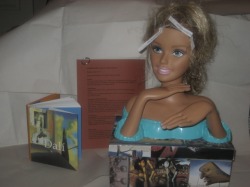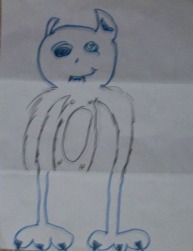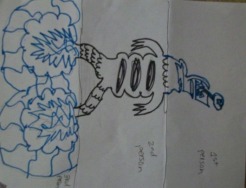Lesson Plans

SURREALISM: Out of My Mind
Grade Level: K-5
Curriculum Areas: Art History, Aesthetics, and Criticism
Goals:
The goal of this lesson is for the students to become acquainted with the surrealist period in art history, and to decide whether or not they think it is appealing and why.
Objectives:
Students will correctly answer questions relating to our discussion on the surrealist period.
Students will be able to use art terms to talk about the works using the elements and principles of design.
Essential Questions:
What is Surrealism?
Why is it important to describe what you see and feel about a work of art?
Who painted the “Persistence of Memory”?
Preparation:
Research the background information regarding Salvador Dali and the Surrealist art movement. Salvador Dali was a surrealist artist in the early 20th century. His work, “The Persistence of Memory” is one of the hallmarks of the surrealist period. His dreamlike images and innovative ideas and attitudes are what make him so recognized throughout the world of art. His works all follow subconscious themes that allow room for interpretation, just like dreams in Freudian philosophy. Run off rubrics, extra prints of the artwork and make sure powerpoint projector is in working order.
Vocabulary:
Surrealism: a period in art history marked by realistic but dreamlike images and subjects that come from the imagination and subconscious.
Salvador Dali: a surrealist artist that completed “The Persistence of Memory,” or “Melting Clocks.”
Shape: spatial form
Line: a path or a point moving in space.
Texture or Feel: surface quality
Repetition or Pattern: the use of an element over and over again.
Dominance or Focal Point: what your eye is drawn toward
Materials:
Art container
Questions for critique
Slideshow (on a CD)
A poster of “The Persistence of Memory” and other surrealist works in case of technical difficultes
Procedures:
Teacher will lecture on surrealism after the slideshow, highlighting main points, like the dreamlike images and imagination behind the works. Go over earlier concepts about elements and principles in order to include those in the discussion. Students will then be asked to participate in a criticism on “The Persistence of Memory” led by questions taken out of the art container (inside the Barbie’s head). Be sure to note how the questions are coming out of Barbie’s head just like the ideas for surrealist works of art came out of the artist’s head.
After the critique, the students will vote on who thinks this is a good work of art, and who does not, addressing the aesthetic concerns of the piece.
Motivation:
Have slideshow of surrealist images showing when students come into the room. Have them sit down and watch the slideshow (which has music) silently. When it is over, start a discussion about what they saw. What was similar and different? What was your favorite?
Presenting Information:
List of questions that will be placed inside of container:
Would you like to be there?
Where does your eye go?
Who made this?
What is happening?
Did the artist really see this place?
How do you think it was made?
How does this artwork make you feel?
What objects do you see? Name 3
Do you see any patterns?
Summarizing the Lesson:
Continue discussion with class by re-addressing the essential questions and making sure students inderstand the importance of analyzing artwork. It is important for us to look at art by famous artists and talk about it so we can look and talk about our own artwork with our classmates. That way we might realize what mistakes we may have made and fix them. We need to realize that our classmates are our partners in helping us do better and we need to help our classmates. We can be a team and help each other instead of putting each other down.
Extensions:
Students may participate in a hands-on group activity where a piece of paper is folded into 3 or 4 sections, depending on group size, and each child draws in one section. The top section should be the head, and the lines that apply should extend into the second section. The second section should be the middle and the bottom should be the feet. Each group will create an imaginary “monster” or “creature” made up from their own imaginations. These creatures may be colored or the activity can be repeated, if time allows.
Modifications For Special Needs:
For cognitively impaired students, the language may be played down, along with the more complex concepts.
For students who are visually impaired, they may be given printouts of the artwork in order to see it closer.
SURREALISM: Out of My Mind
Grade Level: 6-8
Curriculum Areas: Art History, Aesthetics, and Criticism
Goals:
The goal of this lesson is to have students examine surrealist works of art, and determine what makes them visually surreal (subject, treatment of materials, technique, etc.). They will also become familiar with Salvador Dali’s “The Persistence of Memory” through a critique.
Objectives:
Students will identify what makes a work surreal.
Students will actively participate in critique.
Essential Questions:
What makes a work of art surreal?
What are the benefits to participating in an art critique?
Who is Salvador Dali and what did he paint?
Preparation:
Research the background of Salvador Dali and the surrealist movement. The surrealist art movement took place around the 1930’s. The surrealists claimed themselves to be followers of Freud’s principle of the subconscious and the interpretation of dreams. Their work is marked by dreamlike and automatic images that supposedly spring from the subconscious. Dali’s “The Persistence of Memory” is one of the most noted of the surrealist works, and conveys its theme using symbolism. The melting clocks are meant to symbolize that time is not fixed. Salvador Dali was an eccentric and did many bizarre things in his life, including appearing on the Tonight show and refusing to sit on anything but a leather rhinoceros he brought for himself. Run off copies of the rubric, make sure technology for powerpoint projector is working and if not then find prints or posters of surrealist works to show.
Vocabulary:
Surreal: The French proposition ‘sur’ means on top of, so surreal could be described as on top of reality, or above reality.
Salvador Dali: artist who completed “The Persistence of Memory”
Symbolism: using a common object to represent a theme or idea
Theme: the main idea behind an artwork.
Shape: spatial form
Line: a path or a point moving in space.
Texture: surface quality
Repetition: the use of an element over and over again.
Dominance or Focal Point: what your eye is drawn toward
Materials:
Art container
Questions for critique
Slideshow (on a CD)
Procedures:
Teacher will lecture/discuss surrealism with the class, emphasizing what makes all the works fit into one category. The class will then participate in an activity where they critique “The Persistence of Memory” by pulling questions out of the art container. Students will answer questions with class discussion, and debate on whether the artwork is appealing or not.
Motivation:
Have slideshow of surrealist images showing while students walk into class. Save “The Persistence of Memory” until after they have all sat down and watched the rest of the images. Ask if anyone knows what the images have in common, tell them about surrealism and then show “The Persistence of Memory” and ask if anyone has seen it before. Later, discussing some of Dali’s bizarre stories may help the students remain interested.
Presenting Information:
List of questions to be placed inside container:
Would you like to be there?
How do you think it was made?
Why do you think people would like this kind of artwork?
Where does your eye go?
What does surreal mean?
What could be a symbol?
How does this picture make you feel?
What is happening?
What objects do you see? Name 3
Who made it?
Summarizing the Lesson:
Go over the essential questions, and revisit the historical aspects of Surrealism. Emphasize the importance of a critique by asking questions about what the students learned by examining an artwork so closely. Tell students that this process can be used to improve their own artwork.
Extensions:
Students may participate in a hands-on group activity where a piece of paper is folded into 3 or 4 sections, depending on group size, and each child draws in one section. The top section should be the head, and the lines that apply should extend into the second section. The second section should be the middle and the bottom should be the feet. Each group will create an imaginary “monster” or “creature” made up from their own imaginations. These creatures may be colored or the activity can be repeated, if time allows.
Modifications for Special Needs:
For cognitively impaired students, the language may be played down, along with the more complex concepts.
For students who are visually impaired, they may be given printouts of the artwork in order to see it closer.
SURREALISM: Out of My Mind
Grade Level: 9-12
Curriculum Areas: Art History, Aesthetics, and Criticism
Goals:
The goal of this lesson is to have students examine surrealist works of art and understand both visually and conceptually why a work would be considered surreal. They will also become familiar with Salvador Dali’s “The Persistence of Memory” through a critique.
Objectives:
Students will identify visually and conceptually what makes a work surreal.
Students will actively participate in critique.
Essential Questions:
What makes a work of art fit into the surrealist category?
Why are critiques important in art?
Preparation:
Research the historical background of Salvador Dali and the surrealist movement. The surrealist movement of art was inspired by Freudian principles. Andre Breton, the most well-known philosopher of surrealism, defined it as; “pure psychic automatism, by which one proposes to express, either verbally, in writing, or by any other manner, the real functioning of thought. Dictation of thought in the absence of all control exercised by reason, outside of all aesthetic and moral preoccupation.” Though not all works come completely subconsciously, they appear to be straight out of dreams. Dali’s work “The Persistence of Memory” for example, employs the use of symbolism, with the melting clocks meant to represent the inconsistency of time. Print out rubrics. Make sure powerpoint projector is in use and if not then collect surrealist works of art, including “The Persistence of Memory” to show the class.
Vocabulary:
Surreal: The French proposition ‘sur’ means on top of, so surreal could be described as on top of reality, or above reality.
Subconscious: The mind’s thoughts that cannot be reached while awake or aware of them.
Salvador Dali: artist who completed “The Persistence of Memory”
Symbolism: using a common object to represent a theme or idea
Theme: the main idea behind an artwork.
Shape: spatial form
Line: a path or a point moving in space.
Texture: surface quality
Repetition: the use of an element over and over again.
Dominance or Focal Point: what your eye is drawn toward
Materials:
Art container
Questions for critique
Slideshow (on a CD)
Procedures:
Teacher will lecture/discuss surrealism with the class, emphasizing what makes all the works fit into one category. The class will then participate in an activity where they critique “The Persistence of Memory” by pulling questions out of the art container. Students will answer questions with class discussion, and debate on whether the artwork is appealing or not.
Motivation:
Have slideshow of surrealist images showing while students walk into class. Save “The Persistence of Memory” until after they have all sat down and watched the rest of the images. Ask if anyone knows what the images have in common, tell them about surrealism and then show “The Persistence of Memory” and ask if anyone has seen it before. Later, discussing some of Dali’s bizarre stories may help the students remain interested.
Summarizing the Lesson:
Go back over the essential questions, having students debate over whether this exercise was beneficial. Ask them how they could apply it to their own artwork.
Extensions:
Students may participate in a hands-on group activity where a piece of paper is folded into 3 or 4 sections, depending on group size, and each child draws in one section. The top section should be the head, and the lines that apply should extend into the second section. The second section should be the middle and the bottom should be the feet. Each group will create an imaginary “monster” or “creature” made up from their own imaginations. These creatures may be colored or the activity can be repeated, if time allows.
Modifications for Special Needs:
For cognitively impaired students, the language may be played down, along with the more complex concepts.
For students who are visually impaired, they may be given printouts of the artwork in order to see it closer.


